Knowledge Sharing in Virtual Organisations
VerifiedAdded on 2020/11/23
|13
|4042
|381
Literature Review
AI Summary
This assignment examines the impact of well-being and organisational behaviour on employees' knowledge-sharing practices within virtual organisations. It delves into various theoretical perspectives and empirical studies to understand the complex interplay between these factors. The analysis considers how organizational structures, leadership styles, communication strategies, and individual employee characteristics contribute to or hinder knowledge sharing in this unique work environment.
Contribute Materials
Your contribution can guide someone’s learning journey. Share your
documents today.
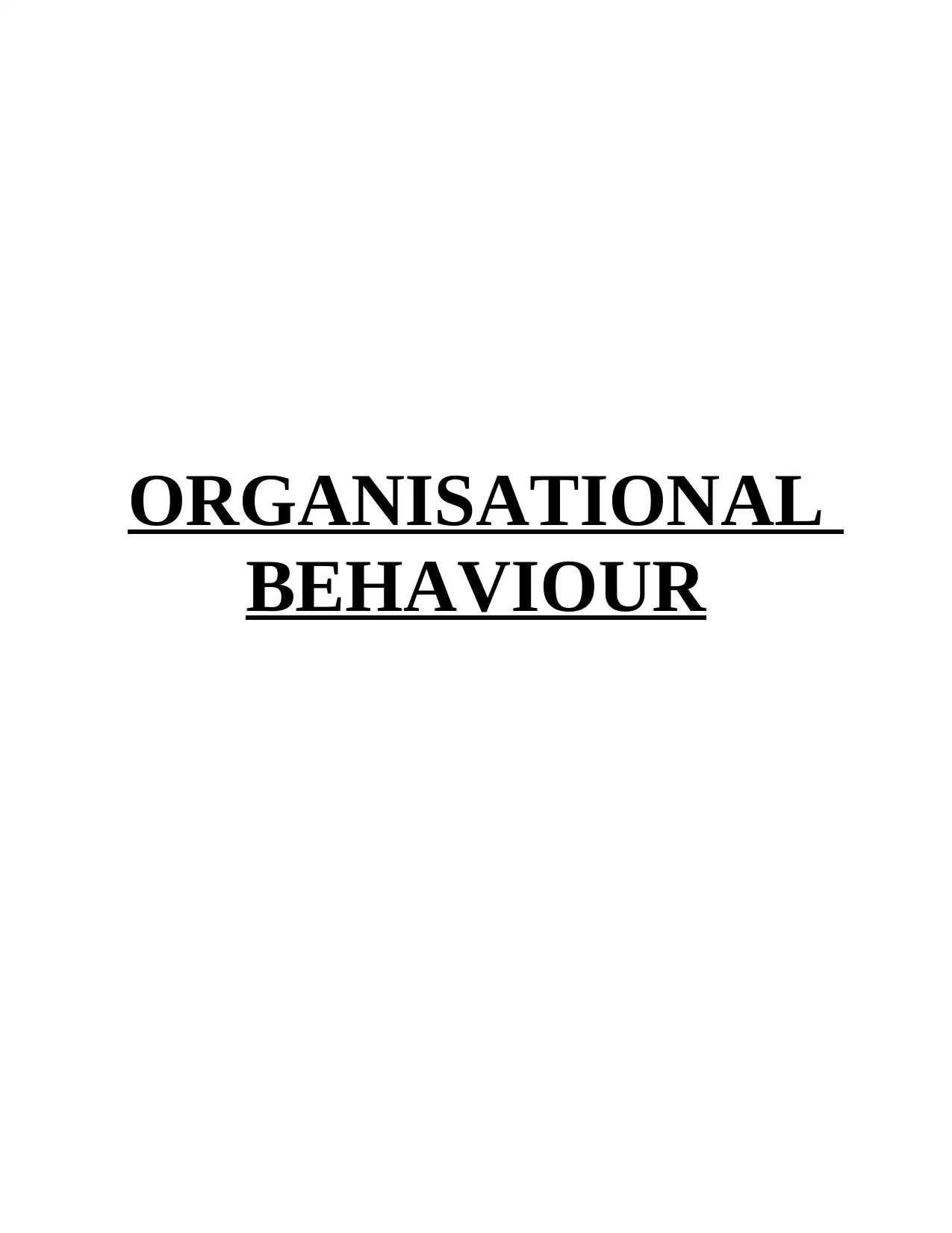
ORGANISATIONAL
BEHAVIOUR
BEHAVIOUR
Secure Best Marks with AI Grader
Need help grading? Try our AI Grader for instant feedback on your assignments.
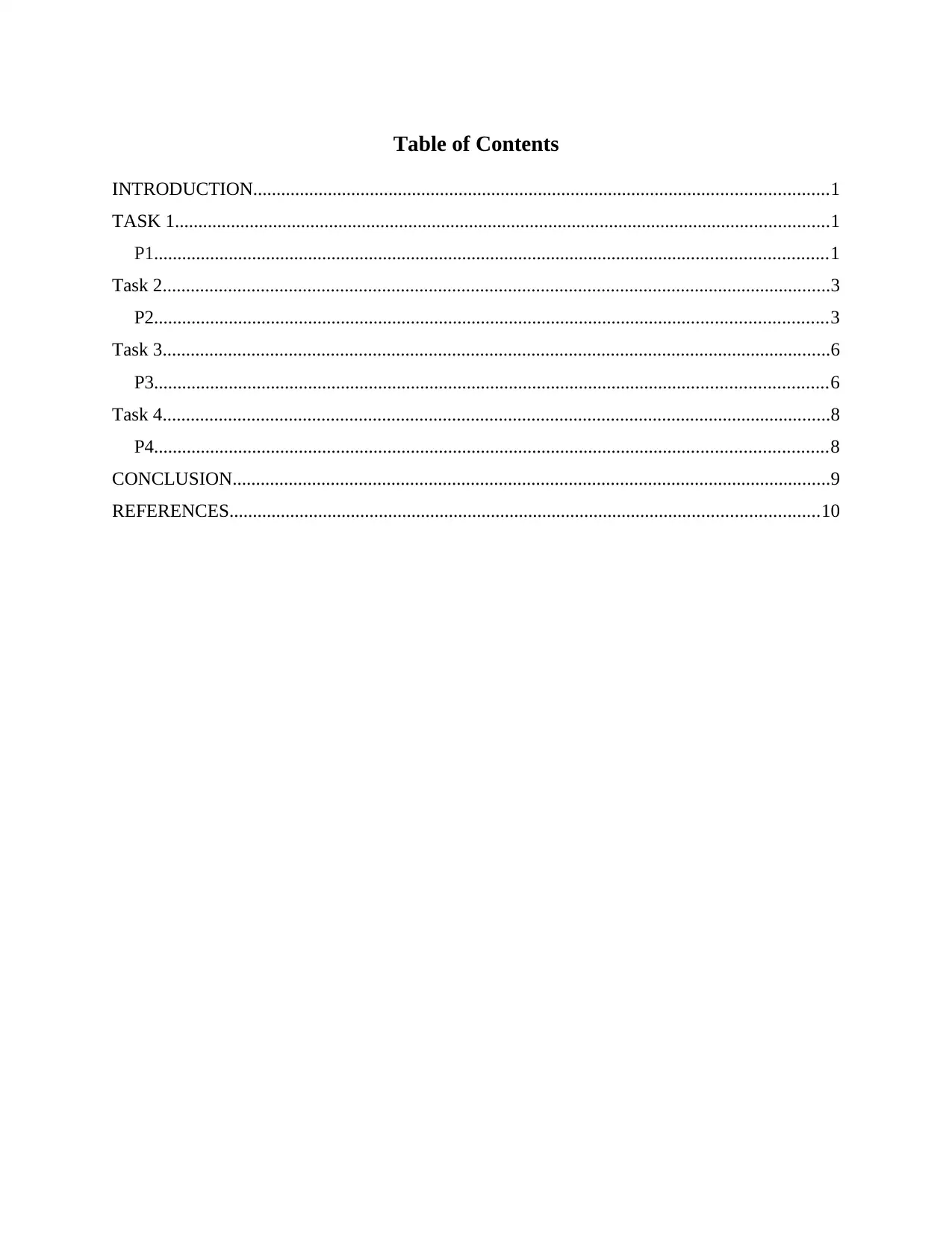
Table of Contents
INTRODUCTION...........................................................................................................................1
TASK 1............................................................................................................................................1
P1................................................................................................................................................1
Task 2...............................................................................................................................................3
P2................................................................................................................................................3
Task 3...............................................................................................................................................6
P3................................................................................................................................................6
Task 4...............................................................................................................................................8
P4................................................................................................................................................8
CONCLUSION................................................................................................................................9
REFERENCES..............................................................................................................................10
INTRODUCTION...........................................................................................................................1
TASK 1............................................................................................................................................1
P1................................................................................................................................................1
Task 2...............................................................................................................................................3
P2................................................................................................................................................3
Task 3...............................................................................................................................................6
P3................................................................................................................................................6
Task 4...............................................................................................................................................8
P4................................................................................................................................................8
CONCLUSION................................................................................................................................9
REFERENCES..............................................................................................................................10
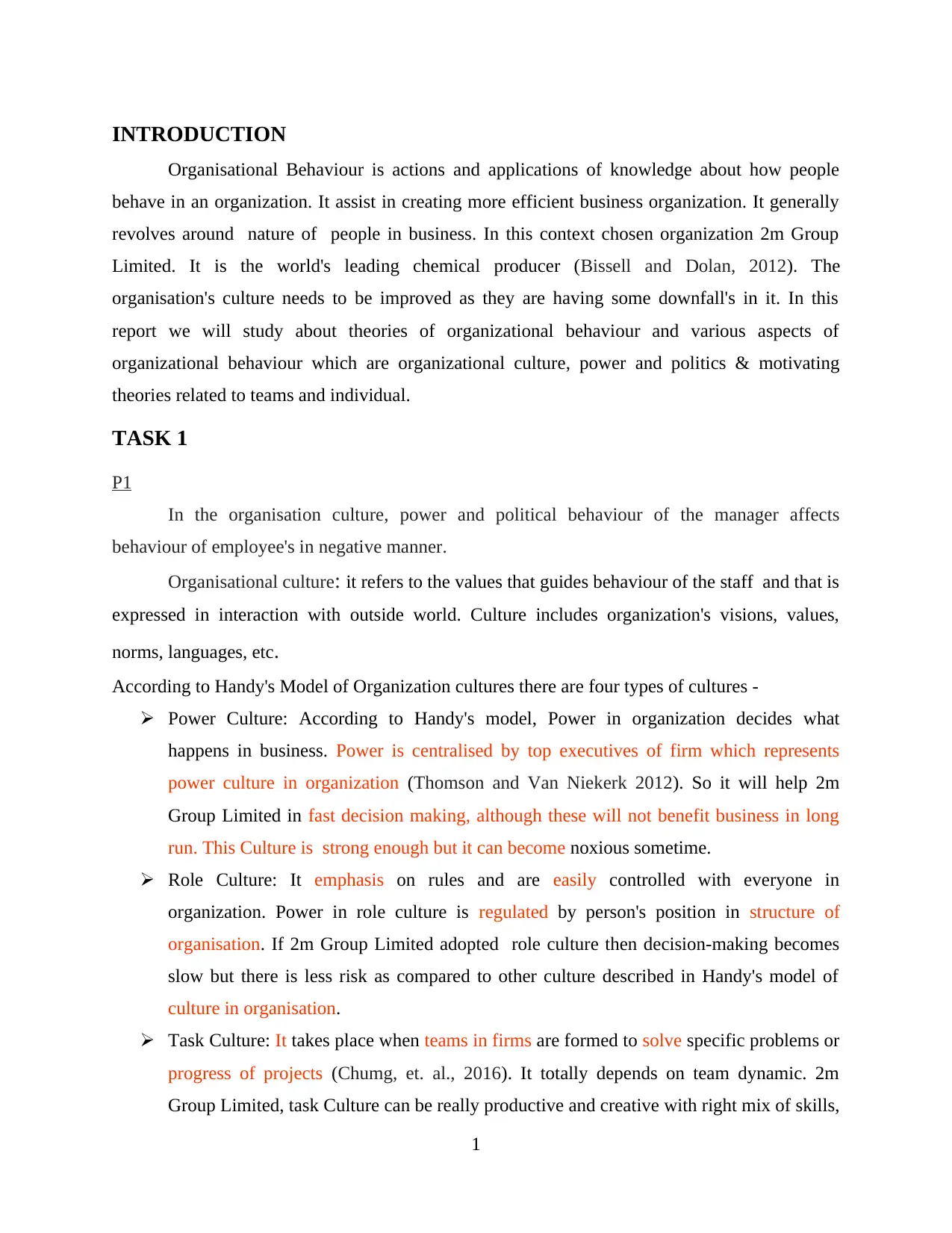
INTRODUCTION
Organisational Behaviour is actions and applications of knowledge about how people
behave in an organization. It assist in creating more efficient business organization. It generally
revolves around nature of people in business. In this context chosen organization 2m Group
Limited. It is the world's leading chemical producer (Bissell and Dolan, 2012). The
organisation's culture needs to be improved as they are having some downfall's in it. In this
report we will study about theories of organizational behaviour and various aspects of
organizational behaviour which are organizational culture, power and politics & motivating
theories related to teams and individual.
TASK 1
P1
In the organisation culture, power and political behaviour of the manager affects
behaviour of employee's in negative manner.
Organisational culture: it refers to the values that guides behaviour of the staff and that is
expressed in interaction with outside world. Culture includes organization's visions, values,
norms, languages, etc.
According to Handy's Model of Organization cultures there are four types of cultures -
Power Culture: According to Handy's model, Power in organization decides what
happens in business. Power is centralised by top executives of firm which represents
power culture in organization (Thomson and Van Niekerk 2012). So it will help 2m
Group Limited in fast decision making, although these will not benefit business in long
run. This Culture is strong enough but it can become noxious sometime.
Role Culture: It emphasis on rules and are easily controlled with everyone in
organization. Power in role culture is regulated by person's position in structure of
organisation. If 2m Group Limited adopted role culture then decision-making becomes
slow but there is less risk as compared to other culture described in Handy's model of
culture in organisation.
Task Culture: It takes place when teams in firms are formed to solve specific problems or
progress of projects (Chumg, et. al., 2016). It totally depends on team dynamic. 2m
Group Limited, task Culture can be really productive and creative with right mix of skills,
1
Organisational Behaviour is actions and applications of knowledge about how people
behave in an organization. It assist in creating more efficient business organization. It generally
revolves around nature of people in business. In this context chosen organization 2m Group
Limited. It is the world's leading chemical producer (Bissell and Dolan, 2012). The
organisation's culture needs to be improved as they are having some downfall's in it. In this
report we will study about theories of organizational behaviour and various aspects of
organizational behaviour which are organizational culture, power and politics & motivating
theories related to teams and individual.
TASK 1
P1
In the organisation culture, power and political behaviour of the manager affects
behaviour of employee's in negative manner.
Organisational culture: it refers to the values that guides behaviour of the staff and that is
expressed in interaction with outside world. Culture includes organization's visions, values,
norms, languages, etc.
According to Handy's Model of Organization cultures there are four types of cultures -
Power Culture: According to Handy's model, Power in organization decides what
happens in business. Power is centralised by top executives of firm which represents
power culture in organization (Thomson and Van Niekerk 2012). So it will help 2m
Group Limited in fast decision making, although these will not benefit business in long
run. This Culture is strong enough but it can become noxious sometime.
Role Culture: It emphasis on rules and are easily controlled with everyone in
organization. Power in role culture is regulated by person's position in structure of
organisation. If 2m Group Limited adopted role culture then decision-making becomes
slow but there is less risk as compared to other culture described in Handy's model of
culture in organisation.
Task Culture: It takes place when teams in firms are formed to solve specific problems or
progress of projects (Chumg, et. al., 2016). It totally depends on team dynamic. 2m
Group Limited, task Culture can be really productive and creative with right mix of skills,
1
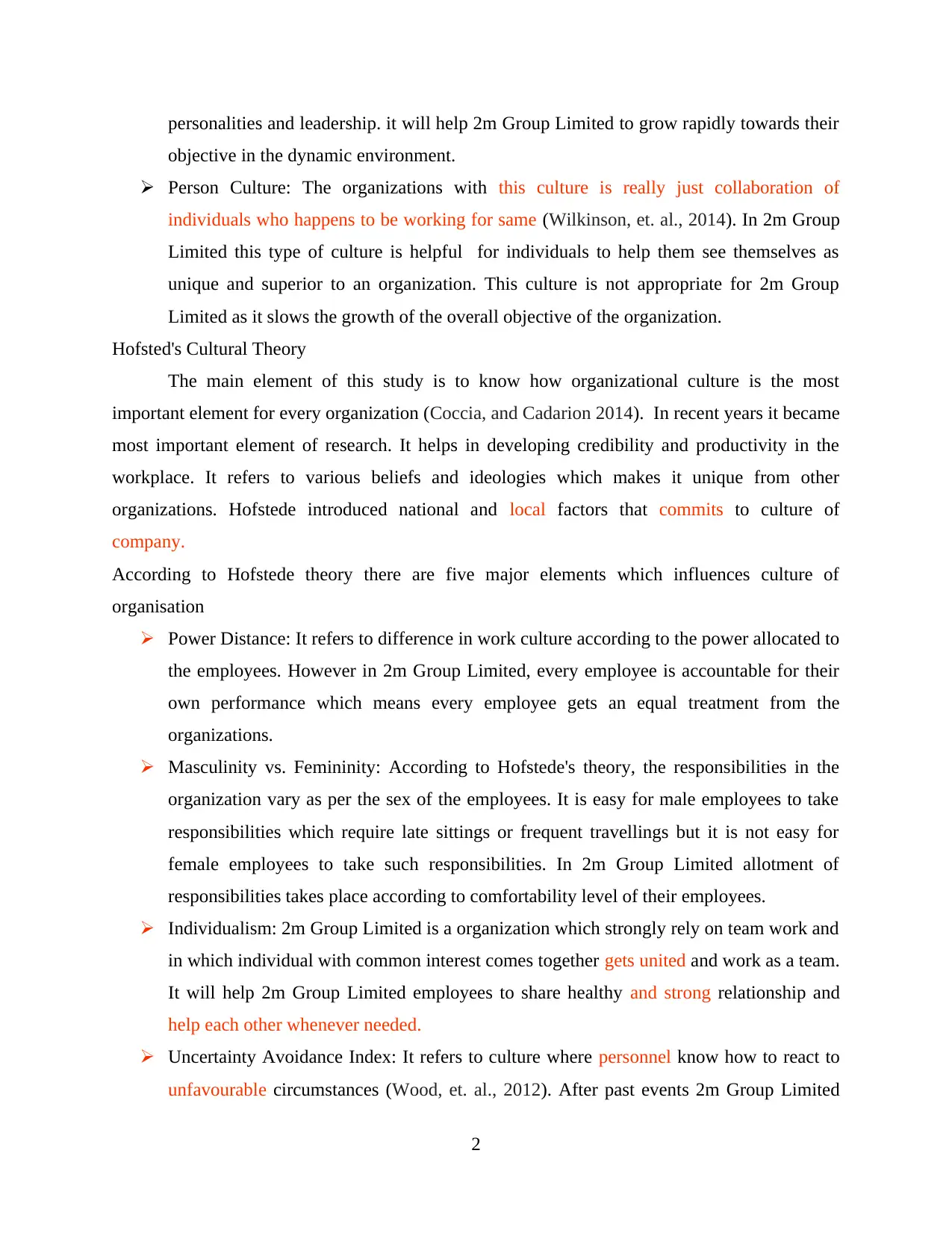
personalities and leadership. it will help 2m Group Limited to grow rapidly towards their
objective in the dynamic environment.
Person Culture: The organizations with this culture is really just collaboration of
individuals who happens to be working for same (Wilkinson, et. al., 2014). In 2m Group
Limited this type of culture is helpful for individuals to help them see themselves as
unique and superior to an organization. This culture is not appropriate for 2m Group
Limited as it slows the growth of the overall objective of the organization.
Hofsted's Cultural Theory
The main element of this study is to know how organizational culture is the most
important element for every organization (Coccia, and Cadarion 2014). In recent years it became
most important element of research. It helps in developing credibility and productivity in the
workplace. It refers to various beliefs and ideologies which makes it unique from other
organizations. Hofstede introduced national and local factors that commits to culture of
company.
According to Hofstede theory there are five major elements which influences culture of
organisation
Power Distance: It refers to difference in work culture according to the power allocated to
the employees. However in 2m Group Limited, every employee is accountable for their
own performance which means every employee gets an equal treatment from the
organizations.
Masculinity vs. Femininity: According to Hofstede's theory, the responsibilities in the
organization vary as per the sex of the employees. It is easy for male employees to take
responsibilities which require late sittings or frequent travellings but it is not easy for
female employees to take such responsibilities. In 2m Group Limited allotment of
responsibilities takes place according to comfortability level of their employees.
Individualism: 2m Group Limited is a organization which strongly rely on team work and
in which individual with common interest comes together gets united and work as a team.
It will help 2m Group Limited employees to share healthy and strong relationship and
help each other whenever needed.
Uncertainty Avoidance Index: It refers to culture where personnel know how to react to
unfavourable circumstances (Wood, et. al., 2012). After past events 2m Group Limited
2
objective in the dynamic environment.
Person Culture: The organizations with this culture is really just collaboration of
individuals who happens to be working for same (Wilkinson, et. al., 2014). In 2m Group
Limited this type of culture is helpful for individuals to help them see themselves as
unique and superior to an organization. This culture is not appropriate for 2m Group
Limited as it slows the growth of the overall objective of the organization.
Hofsted's Cultural Theory
The main element of this study is to know how organizational culture is the most
important element for every organization (Coccia, and Cadarion 2014). In recent years it became
most important element of research. It helps in developing credibility and productivity in the
workplace. It refers to various beliefs and ideologies which makes it unique from other
organizations. Hofstede introduced national and local factors that commits to culture of
company.
According to Hofstede theory there are five major elements which influences culture of
organisation
Power Distance: It refers to difference in work culture according to the power allocated to
the employees. However in 2m Group Limited, every employee is accountable for their
own performance which means every employee gets an equal treatment from the
organizations.
Masculinity vs. Femininity: According to Hofstede's theory, the responsibilities in the
organization vary as per the sex of the employees. It is easy for male employees to take
responsibilities which require late sittings or frequent travellings but it is not easy for
female employees to take such responsibilities. In 2m Group Limited allotment of
responsibilities takes place according to comfortability level of their employees.
Individualism: 2m Group Limited is a organization which strongly rely on team work and
in which individual with common interest comes together gets united and work as a team.
It will help 2m Group Limited employees to share healthy and strong relationship and
help each other whenever needed.
Uncertainty Avoidance Index: It refers to culture where personnel know how to react to
unfavourable circumstances (Wood, et. al., 2012). After past events 2m Group Limited
2
Secure Best Marks with AI Grader
Need help grading? Try our AI Grader for instant feedback on your assignments.
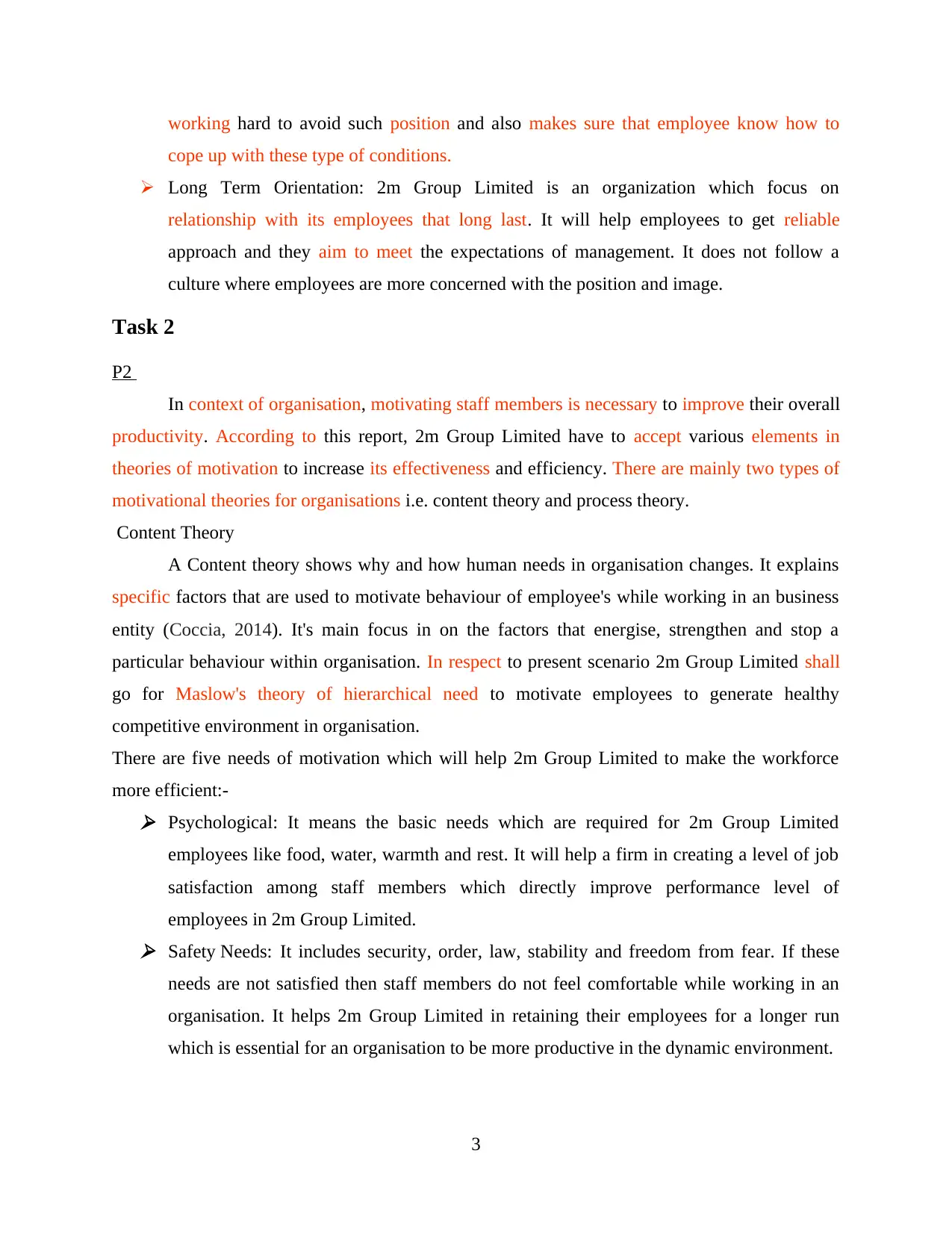
working hard to avoid such position and also makes sure that employee know how to
cope up with these type of conditions.
Long Term Orientation: 2m Group Limited is an organization which focus on
relationship with its employees that long last. It will help employees to get reliable
approach and they aim to meet the expectations of management. It does not follow a
culture where employees are more concerned with the position and image.
Task 2
P2
In context of organisation, motivating staff members is necessary to improve their overall
productivity. According to this report, 2m Group Limited have to accept various elements in
theories of motivation to increase its effectiveness and efficiency. There are mainly two types of
motivational theories for organisations i.e. content theory and process theory.
Content Theory
A Content theory shows why and how human needs in organisation changes. It explains
specific factors that are used to motivate behaviour of employee's while working in an business
entity (Coccia, 2014). It's main focus in on the factors that energise, strengthen and stop a
particular behaviour within organisation. In respect to present scenario 2m Group Limited shall
go for Maslow's theory of hierarchical need to motivate employees to generate healthy
competitive environment in organisation.
There are five needs of motivation which will help 2m Group Limited to make the workforce
more efficient:- Psychological: It means the basic needs which are required for 2m Group Limited
employees like food, water, warmth and rest. It will help a firm in creating a level of job
satisfaction among staff members which directly improve performance level of
employees in 2m Group Limited. Safety Needs: It includes security, order, law, stability and freedom from fear. If these
needs are not satisfied then staff members do not feel comfortable while working in an
organisation. It helps 2m Group Limited in retaining their employees for a longer run
which is essential for an organisation to be more productive in the dynamic environment.
3
cope up with these type of conditions.
Long Term Orientation: 2m Group Limited is an organization which focus on
relationship with its employees that long last. It will help employees to get reliable
approach and they aim to meet the expectations of management. It does not follow a
culture where employees are more concerned with the position and image.
Task 2
P2
In context of organisation, motivating staff members is necessary to improve their overall
productivity. According to this report, 2m Group Limited have to accept various elements in
theories of motivation to increase its effectiveness and efficiency. There are mainly two types of
motivational theories for organisations i.e. content theory and process theory.
Content Theory
A Content theory shows why and how human needs in organisation changes. It explains
specific factors that are used to motivate behaviour of employee's while working in an business
entity (Coccia, 2014). It's main focus in on the factors that energise, strengthen and stop a
particular behaviour within organisation. In respect to present scenario 2m Group Limited shall
go for Maslow's theory of hierarchical need to motivate employees to generate healthy
competitive environment in organisation.
There are five needs of motivation which will help 2m Group Limited to make the workforce
more efficient:- Psychological: It means the basic needs which are required for 2m Group Limited
employees like food, water, warmth and rest. It will help a firm in creating a level of job
satisfaction among staff members which directly improve performance level of
employees in 2m Group Limited. Safety Needs: It includes security, order, law, stability and freedom from fear. If these
needs are not satisfied then staff members do not feel comfortable while working in an
organisation. It helps 2m Group Limited in retaining their employees for a longer run
which is essential for an organisation to be more productive in the dynamic environment.
3
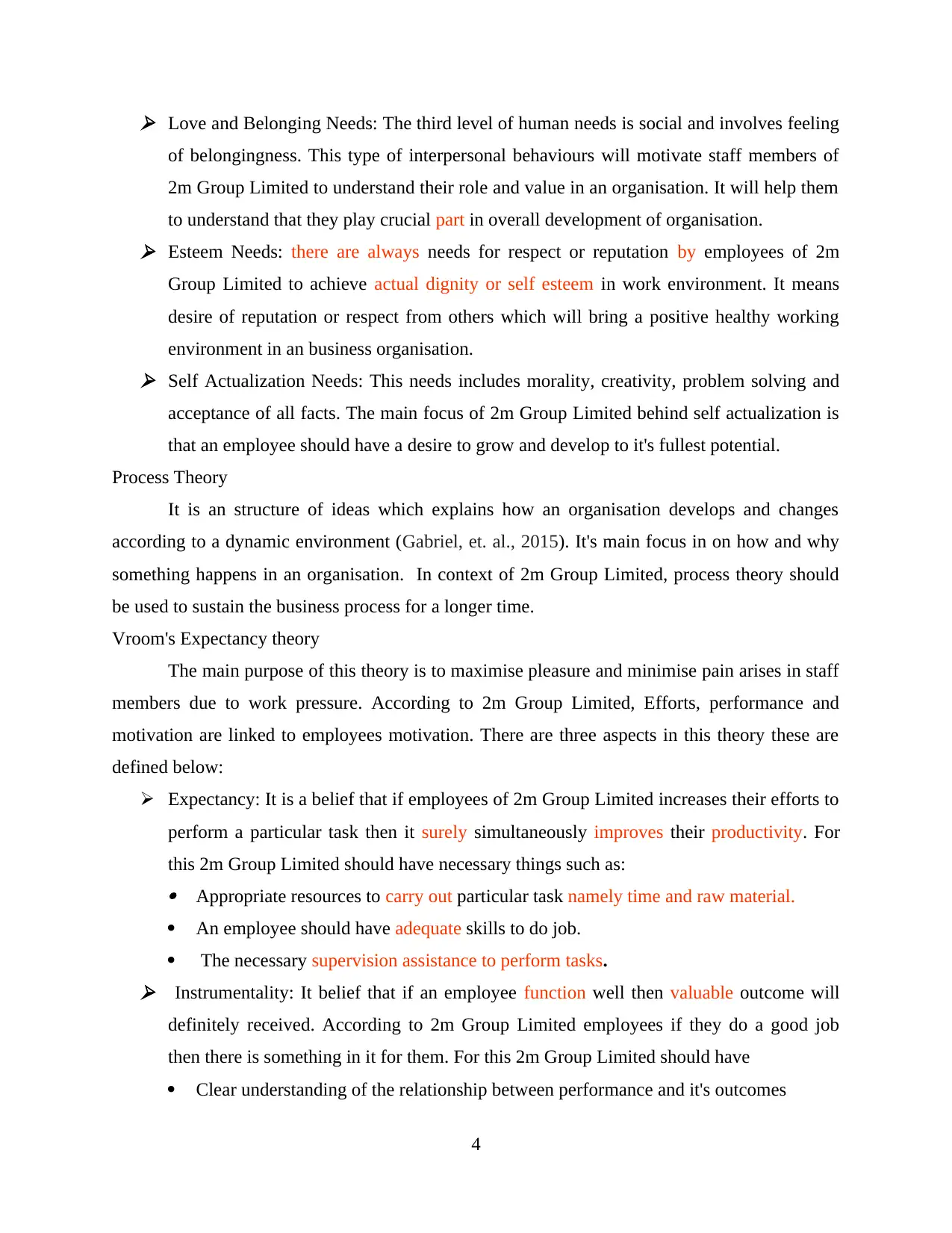
Love and Belonging Needs: The third level of human needs is social and involves feeling
of belongingness. This type of interpersonal behaviours will motivate staff members of
2m Group Limited to understand their role and value in an organisation. It will help them
to understand that they play crucial part in overall development of organisation. Esteem Needs: there are always needs for respect or reputation by employees of 2m
Group Limited to achieve actual dignity or self esteem in work environment. It means
desire of reputation or respect from others which will bring a positive healthy working
environment in an business organisation. Self Actualization Needs: This needs includes morality, creativity, problem solving and
acceptance of all facts. The main focus of 2m Group Limited behind self actualization is
that an employee should have a desire to grow and develop to it's fullest potential.
Process Theory
It is an structure of ideas which explains how an organisation develops and changes
according to a dynamic environment (Gabriel, et. al., 2015). It's main focus in on how and why
something happens in an organisation. In context of 2m Group Limited, process theory should
be used to sustain the business process for a longer time.
Vroom's Expectancy theory
The main purpose of this theory is to maximise pleasure and minimise pain arises in staff
members due to work pressure. According to 2m Group Limited, Efforts, performance and
motivation are linked to employees motivation. There are three aspects in this theory these are
defined below:
Expectancy: It is a belief that if employees of 2m Group Limited increases their efforts to
perform a particular task then it surely simultaneously improves their productivity. For
this 2m Group Limited should have necessary things such as:
Appropriate resources to carry out particular task namely time and raw material.
An employee should have adequate skills to do job.
The necessary supervision assistance to perform tasks. Instrumentality: It belief that if an employee function well then valuable outcome will
definitely received. According to 2m Group Limited employees if they do a good job
then there is something in it for them. For this 2m Group Limited should have
Clear understanding of the relationship between performance and it's outcomes
4
of belongingness. This type of interpersonal behaviours will motivate staff members of
2m Group Limited to understand their role and value in an organisation. It will help them
to understand that they play crucial part in overall development of organisation. Esteem Needs: there are always needs for respect or reputation by employees of 2m
Group Limited to achieve actual dignity or self esteem in work environment. It means
desire of reputation or respect from others which will bring a positive healthy working
environment in an business organisation. Self Actualization Needs: This needs includes morality, creativity, problem solving and
acceptance of all facts. The main focus of 2m Group Limited behind self actualization is
that an employee should have a desire to grow and develop to it's fullest potential.
Process Theory
It is an structure of ideas which explains how an organisation develops and changes
according to a dynamic environment (Gabriel, et. al., 2015). It's main focus in on how and why
something happens in an organisation. In context of 2m Group Limited, process theory should
be used to sustain the business process for a longer time.
Vroom's Expectancy theory
The main purpose of this theory is to maximise pleasure and minimise pain arises in staff
members due to work pressure. According to 2m Group Limited, Efforts, performance and
motivation are linked to employees motivation. There are three aspects in this theory these are
defined below:
Expectancy: It is a belief that if employees of 2m Group Limited increases their efforts to
perform a particular task then it surely simultaneously improves their productivity. For
this 2m Group Limited should have necessary things such as:
Appropriate resources to carry out particular task namely time and raw material.
An employee should have adequate skills to do job.
The necessary supervision assistance to perform tasks. Instrumentality: It belief that if an employee function well then valuable outcome will
definitely received. According to 2m Group Limited employees if they do a good job
then there is something in it for them. For this 2m Group Limited should have
Clear understanding of the relationship between performance and it's outcomes
4
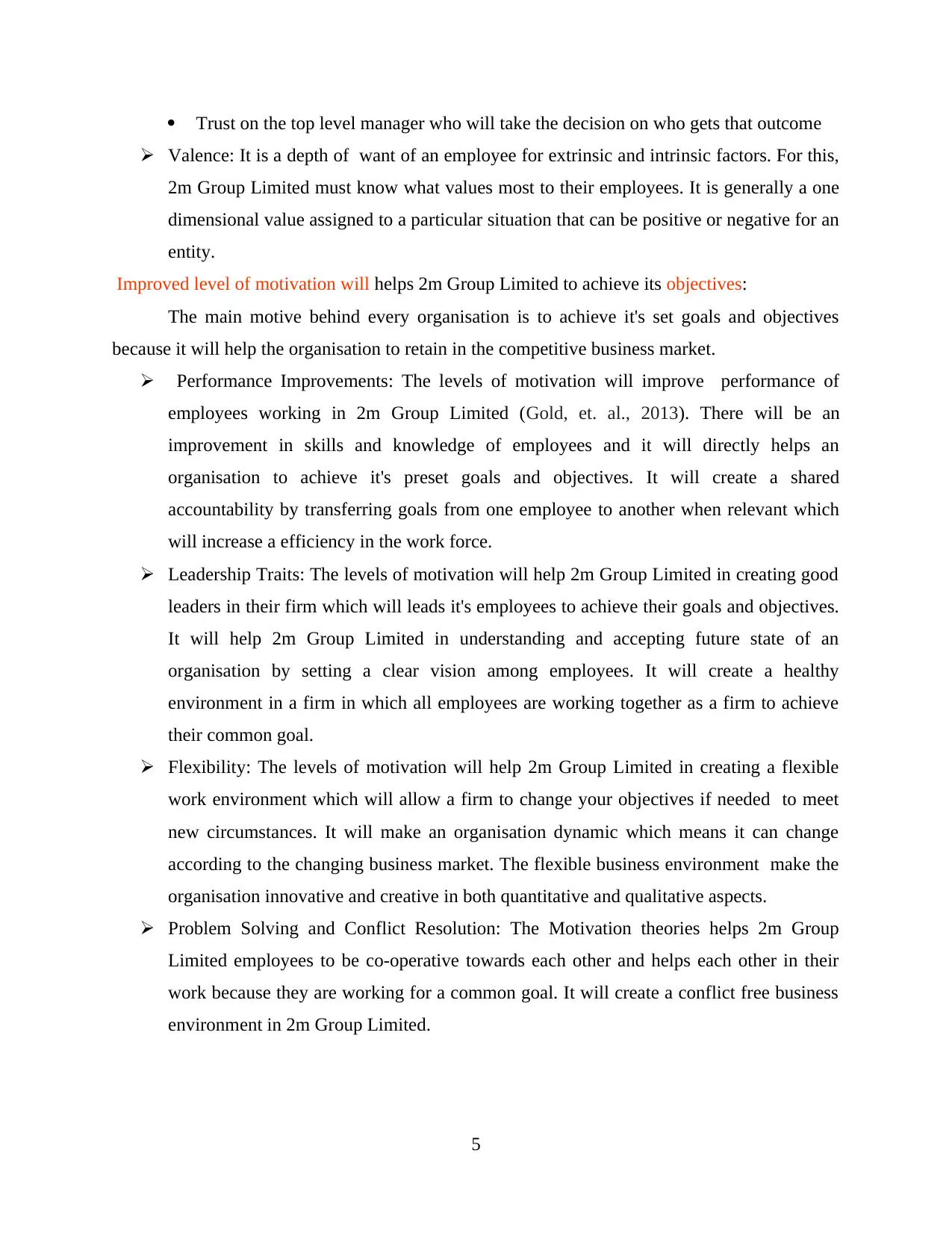
Trust on the top level manager who will take the decision on who gets that outcome
Valence: It is a depth of want of an employee for extrinsic and intrinsic factors. For this,
2m Group Limited must know what values most to their employees. It is generally a one
dimensional value assigned to a particular situation that can be positive or negative for an
entity.
Improved level of motivation will helps 2m Group Limited to achieve its objectives:
The main motive behind every organisation is to achieve it's set goals and objectives
because it will help the organisation to retain in the competitive business market.
Performance Improvements: The levels of motivation will improve performance of
employees working in 2m Group Limited (Gold, et. al., 2013). There will be an
improvement in skills and knowledge of employees and it will directly helps an
organisation to achieve it's preset goals and objectives. It will create a shared
accountability by transferring goals from one employee to another when relevant which
will increase a efficiency in the work force.
Leadership Traits: The levels of motivation will help 2m Group Limited in creating good
leaders in their firm which will leads it's employees to achieve their goals and objectives.
It will help 2m Group Limited in understanding and accepting future state of an
organisation by setting a clear vision among employees. It will create a healthy
environment in a firm in which all employees are working together as a firm to achieve
their common goal.
Flexibility: The levels of motivation will help 2m Group Limited in creating a flexible
work environment which will allow a firm to change your objectives if needed to meet
new circumstances. It will make an organisation dynamic which means it can change
according to the changing business market. The flexible business environment make the
organisation innovative and creative in both quantitative and qualitative aspects.
Problem Solving and Conflict Resolution: The Motivation theories helps 2m Group
Limited employees to be co-operative towards each other and helps each other in their
work because they are working for a common goal. It will create a conflict free business
environment in 2m Group Limited.
5
Valence: It is a depth of want of an employee for extrinsic and intrinsic factors. For this,
2m Group Limited must know what values most to their employees. It is generally a one
dimensional value assigned to a particular situation that can be positive or negative for an
entity.
Improved level of motivation will helps 2m Group Limited to achieve its objectives:
The main motive behind every organisation is to achieve it's set goals and objectives
because it will help the organisation to retain in the competitive business market.
Performance Improvements: The levels of motivation will improve performance of
employees working in 2m Group Limited (Gold, et. al., 2013). There will be an
improvement in skills and knowledge of employees and it will directly helps an
organisation to achieve it's preset goals and objectives. It will create a shared
accountability by transferring goals from one employee to another when relevant which
will increase a efficiency in the work force.
Leadership Traits: The levels of motivation will help 2m Group Limited in creating good
leaders in their firm which will leads it's employees to achieve their goals and objectives.
It will help 2m Group Limited in understanding and accepting future state of an
organisation by setting a clear vision among employees. It will create a healthy
environment in a firm in which all employees are working together as a firm to achieve
their common goal.
Flexibility: The levels of motivation will help 2m Group Limited in creating a flexible
work environment which will allow a firm to change your objectives if needed to meet
new circumstances. It will make an organisation dynamic which means it can change
according to the changing business market. The flexible business environment make the
organisation innovative and creative in both quantitative and qualitative aspects.
Problem Solving and Conflict Resolution: The Motivation theories helps 2m Group
Limited employees to be co-operative towards each other and helps each other in their
work because they are working for a common goal. It will create a conflict free business
environment in 2m Group Limited.
5
Paraphrase This Document
Need a fresh take? Get an instant paraphrase of this document with our AI Paraphraser
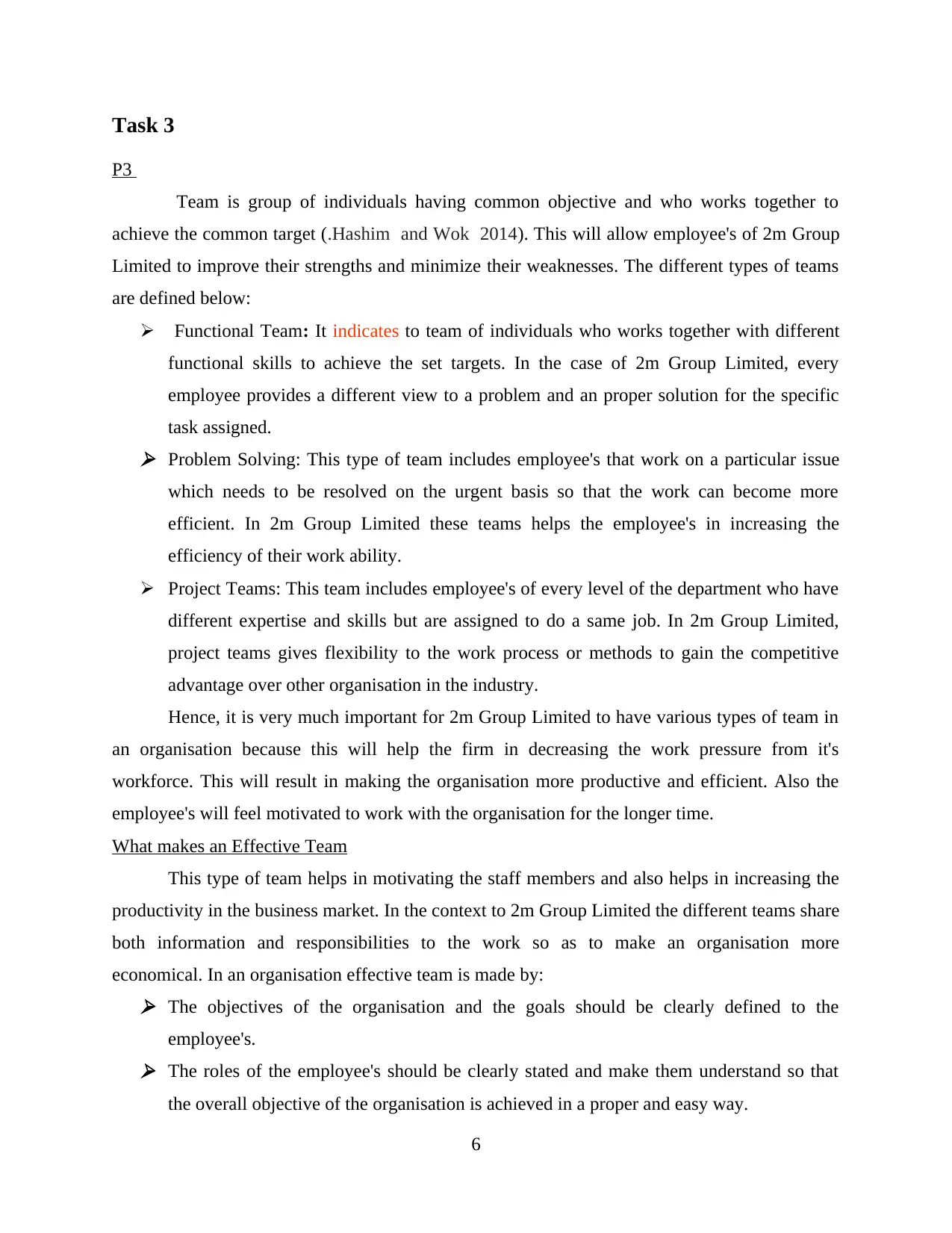
Task 3
P3
Team is group of individuals having common objective and who works together to
achieve the common target (.Hashim and Wok 2014). This will allow employee's of 2m Group
Limited to improve their strengths and minimize their weaknesses. The different types of teams
are defined below:
Functional Team: It indicates to team of individuals who works together with different
functional skills to achieve the set targets. In the case of 2m Group Limited, every
employee provides a different view to a problem and an proper solution for the specific
task assigned. Problem Solving: This type of team includes employee's that work on a particular issue
which needs to be resolved on the urgent basis so that the work can become more
efficient. In 2m Group Limited these teams helps the employee's in increasing the
efficiency of their work ability.
Project Teams: This team includes employee's of every level of the department who have
different expertise and skills but are assigned to do a same job. In 2m Group Limited,
project teams gives flexibility to the work process or methods to gain the competitive
advantage over other organisation in the industry.
Hence, it is very much important for 2m Group Limited to have various types of team in
an organisation because this will help the firm in decreasing the work pressure from it's
workforce. This will result in making the organisation more productive and efficient. Also the
employee's will feel motivated to work with the organisation for the longer time.
What makes an Effective Team
This type of team helps in motivating the staff members and also helps in increasing the
productivity in the business market. In the context to 2m Group Limited the different teams share
both information and responsibilities to the work so as to make an organisation more
economical. In an organisation effective team is made by: The objectives of the organisation and the goals should be clearly defined to the
employee's. The roles of the employee's should be clearly stated and make them understand so that
the overall objective of the organisation is achieved in a proper and easy way.
6
P3
Team is group of individuals having common objective and who works together to
achieve the common target (.Hashim and Wok 2014). This will allow employee's of 2m Group
Limited to improve their strengths and minimize their weaknesses. The different types of teams
are defined below:
Functional Team: It indicates to team of individuals who works together with different
functional skills to achieve the set targets. In the case of 2m Group Limited, every
employee provides a different view to a problem and an proper solution for the specific
task assigned. Problem Solving: This type of team includes employee's that work on a particular issue
which needs to be resolved on the urgent basis so that the work can become more
efficient. In 2m Group Limited these teams helps the employee's in increasing the
efficiency of their work ability.
Project Teams: This team includes employee's of every level of the department who have
different expertise and skills but are assigned to do a same job. In 2m Group Limited,
project teams gives flexibility to the work process or methods to gain the competitive
advantage over other organisation in the industry.
Hence, it is very much important for 2m Group Limited to have various types of team in
an organisation because this will help the firm in decreasing the work pressure from it's
workforce. This will result in making the organisation more productive and efficient. Also the
employee's will feel motivated to work with the organisation for the longer time.
What makes an Effective Team
This type of team helps in motivating the staff members and also helps in increasing the
productivity in the business market. In the context to 2m Group Limited the different teams share
both information and responsibilities to the work so as to make an organisation more
economical. In an organisation effective team is made by: The objectives of the organisation and the goals should be clearly defined to the
employee's. The roles of the employee's should be clearly stated and make them understand so that
the overall objective of the organisation is achieved in a proper and easy way.
6
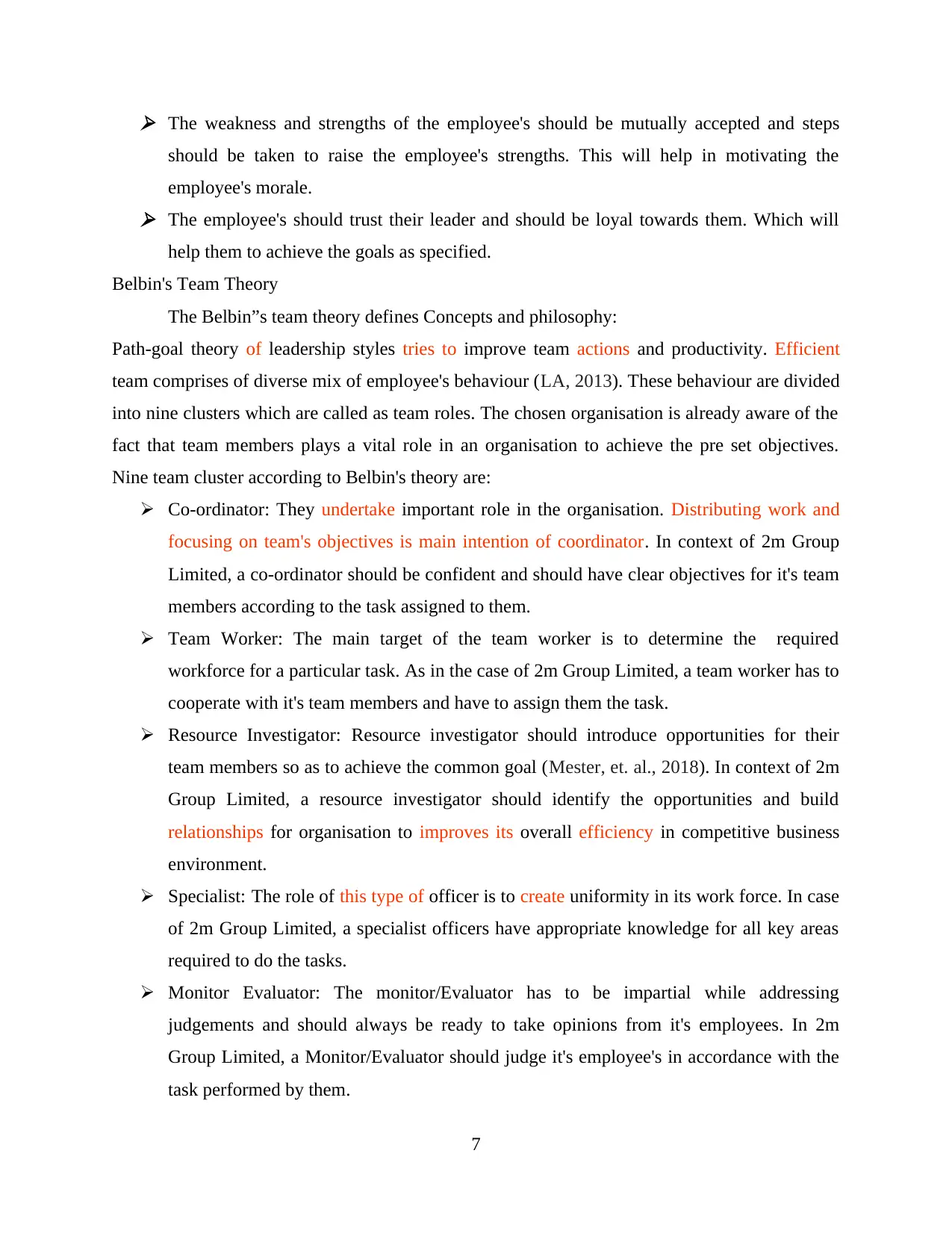
The weakness and strengths of the employee's should be mutually accepted and steps
should be taken to raise the employee's strengths. This will help in motivating the
employee's morale. The employee's should trust their leader and should be loyal towards them. Which will
help them to achieve the goals as specified.
Belbin's Team Theory
The Belbin”s team theory defines Concepts and philosophy:
Path-goal theory of leadership styles tries to improve team actions and productivity. Efficient
team comprises of diverse mix of employee's behaviour (LA, 2013). These behaviour are divided
into nine clusters which are called as team roles. The chosen organisation is already aware of the
fact that team members plays a vital role in an organisation to achieve the pre set objectives.
Nine team cluster according to Belbin's theory are:
Co-ordinator: They undertake important role in the organisation. Distributing work and
focusing on team's objectives is main intention of coordinator. In context of 2m Group
Limited, a co-ordinator should be confident and should have clear objectives for it's team
members according to the task assigned to them.
Team Worker: The main target of the team worker is to determine the required
workforce for a particular task. As in the case of 2m Group Limited, a team worker has to
cooperate with it's team members and have to assign them the task.
Resource Investigator: Resource investigator should introduce opportunities for their
team members so as to achieve the common goal (Mester, et. al., 2018). In context of 2m
Group Limited, a resource investigator should identify the opportunities and build
relationships for organisation to improves its overall efficiency in competitive business
environment.
Specialist: The role of this type of officer is to create uniformity in its work force. In case
of 2m Group Limited, a specialist officers have appropriate knowledge for all key areas
required to do the tasks.
Monitor Evaluator: The monitor/Evaluator has to be impartial while addressing
judgements and should always be ready to take opinions from it's employees. In 2m
Group Limited, a Monitor/Evaluator should judge it's employee's in accordance with the
task performed by them.
7
should be taken to raise the employee's strengths. This will help in motivating the
employee's morale. The employee's should trust their leader and should be loyal towards them. Which will
help them to achieve the goals as specified.
Belbin's Team Theory
The Belbin”s team theory defines Concepts and philosophy:
Path-goal theory of leadership styles tries to improve team actions and productivity. Efficient
team comprises of diverse mix of employee's behaviour (LA, 2013). These behaviour are divided
into nine clusters which are called as team roles. The chosen organisation is already aware of the
fact that team members plays a vital role in an organisation to achieve the pre set objectives.
Nine team cluster according to Belbin's theory are:
Co-ordinator: They undertake important role in the organisation. Distributing work and
focusing on team's objectives is main intention of coordinator. In context of 2m Group
Limited, a co-ordinator should be confident and should have clear objectives for it's team
members according to the task assigned to them.
Team Worker: The main target of the team worker is to determine the required
workforce for a particular task. As in the case of 2m Group Limited, a team worker has to
cooperate with it's team members and have to assign them the task.
Resource Investigator: Resource investigator should introduce opportunities for their
team members so as to achieve the common goal (Mester, et. al., 2018). In context of 2m
Group Limited, a resource investigator should identify the opportunities and build
relationships for organisation to improves its overall efficiency in competitive business
environment.
Specialist: The role of this type of officer is to create uniformity in its work force. In case
of 2m Group Limited, a specialist officers have appropriate knowledge for all key areas
required to do the tasks.
Monitor Evaluator: The monitor/Evaluator has to be impartial while addressing
judgements and should always be ready to take opinions from it's employees. In 2m
Group Limited, a Monitor/Evaluator should judge it's employee's in accordance with the
task performed by them.
7
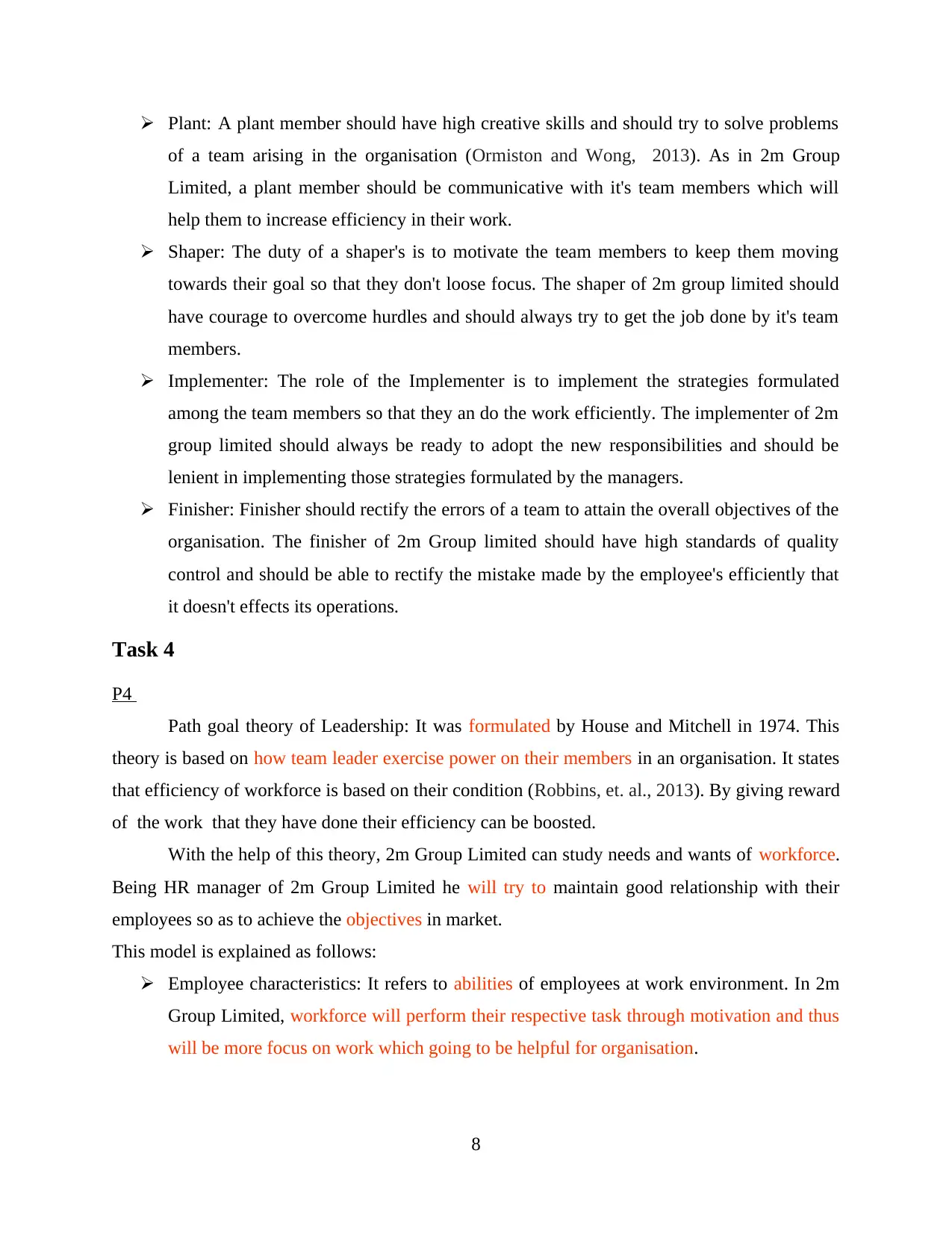
Plant: A plant member should have high creative skills and should try to solve problems
of a team arising in the organisation (Ormiston and Wong, 2013). As in 2m Group
Limited, a plant member should be communicative with it's team members which will
help them to increase efficiency in their work.
Shaper: The duty of a shaper's is to motivate the team members to keep them moving
towards their goal so that they don't loose focus. The shaper of 2m group limited should
have courage to overcome hurdles and should always try to get the job done by it's team
members.
Implementer: The role of the Implementer is to implement the strategies formulated
among the team members so that they an do the work efficiently. The implementer of 2m
group limited should always be ready to adopt the new responsibilities and should be
lenient in implementing those strategies formulated by the managers.
Finisher: Finisher should rectify the errors of a team to attain the overall objectives of the
organisation. The finisher of 2m Group limited should have high standards of quality
control and should be able to rectify the mistake made by the employee's efficiently that
it doesn't effects its operations.
Task 4
P4
Path goal theory of Leadership: It was formulated by House and Mitchell in 1974. This
theory is based on how team leader exercise power on their members in an organisation. It states
that efficiency of workforce is based on their condition (Robbins, et. al., 2013). By giving reward
of the work that they have done their efficiency can be boosted.
With the help of this theory, 2m Group Limited can study needs and wants of workforce.
Being HR manager of 2m Group Limited he will try to maintain good relationship with their
employees so as to achieve the objectives in market.
This model is explained as follows:
Employee characteristics: It refers to abilities of employees at work environment. In 2m
Group Limited, workforce will perform their respective task through motivation and thus
will be more focus on work which going to be helpful for organisation.
8
of a team arising in the organisation (Ormiston and Wong, 2013). As in 2m Group
Limited, a plant member should be communicative with it's team members which will
help them to increase efficiency in their work.
Shaper: The duty of a shaper's is to motivate the team members to keep them moving
towards their goal so that they don't loose focus. The shaper of 2m group limited should
have courage to overcome hurdles and should always try to get the job done by it's team
members.
Implementer: The role of the Implementer is to implement the strategies formulated
among the team members so that they an do the work efficiently. The implementer of 2m
group limited should always be ready to adopt the new responsibilities and should be
lenient in implementing those strategies formulated by the managers.
Finisher: Finisher should rectify the errors of a team to attain the overall objectives of the
organisation. The finisher of 2m Group limited should have high standards of quality
control and should be able to rectify the mistake made by the employee's efficiently that
it doesn't effects its operations.
Task 4
P4
Path goal theory of Leadership: It was formulated by House and Mitchell in 1974. This
theory is based on how team leader exercise power on their members in an organisation. It states
that efficiency of workforce is based on their condition (Robbins, et. al., 2013). By giving reward
of the work that they have done their efficiency can be boosted.
With the help of this theory, 2m Group Limited can study needs and wants of workforce.
Being HR manager of 2m Group Limited he will try to maintain good relationship with their
employees so as to achieve the objectives in market.
This model is explained as follows:
Employee characteristics: It refers to abilities of employees at work environment. In 2m
Group Limited, workforce will perform their respective task through motivation and thus
will be more focus on work which going to be helpful for organisation.
8
Secure Best Marks with AI Grader
Need help grading? Try our AI Grader for instant feedback on your assignments.
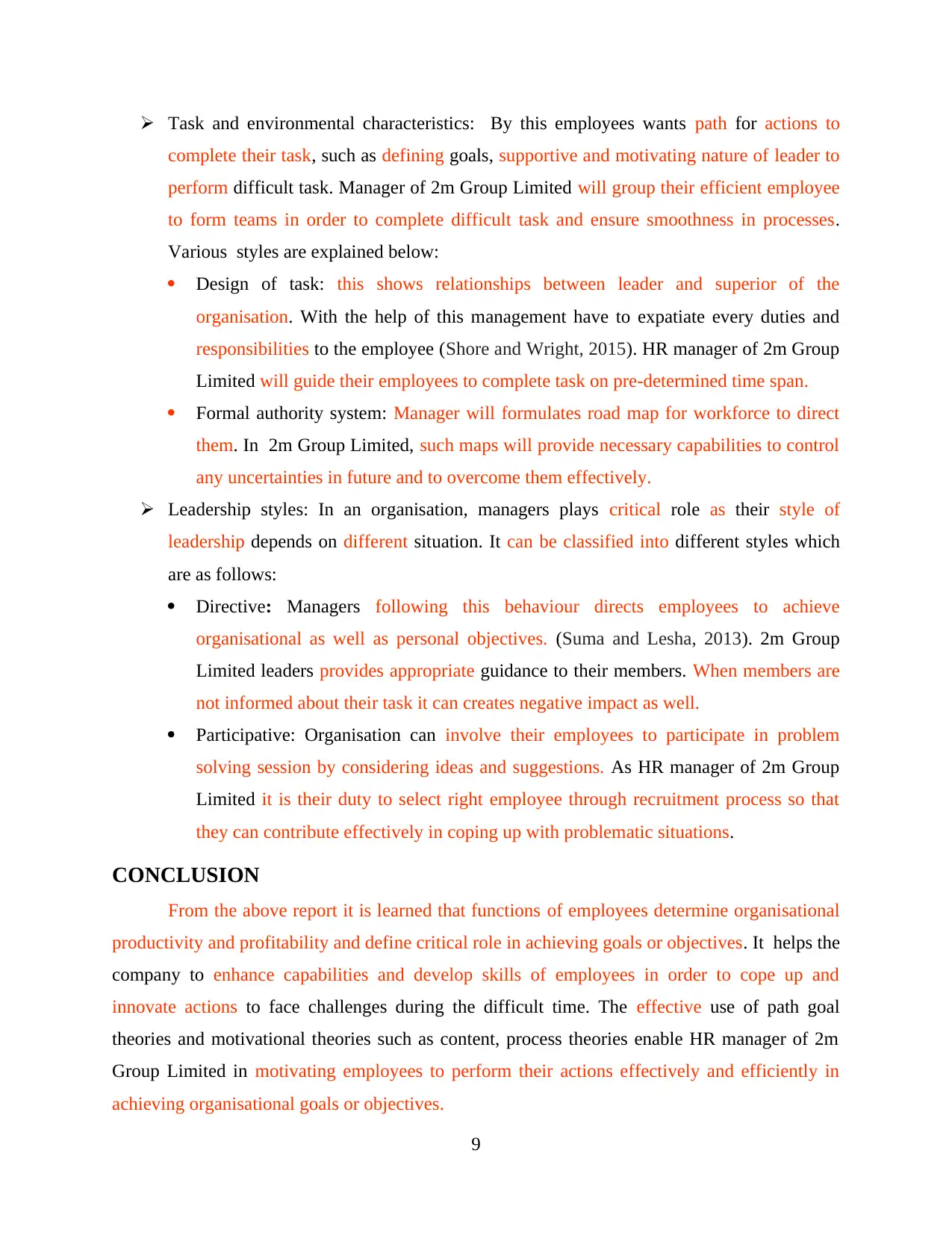
Task and environmental characteristics: By this employees wants path for actions to
complete their task, such as defining goals, supportive and motivating nature of leader to
perform difficult task. Manager of 2m Group Limited will group their efficient employee
to form teams in order to complete difficult task and ensure smoothness in processes.
Various styles are explained below:
Design of task: this shows relationships between leader and superior of the
organisation. With the help of this management have to expatiate every duties and
responsibilities to the employee (Shore and Wright, 2015). HR manager of 2m Group
Limited will guide their employees to complete task on pre-determined time span.
Formal authority system: Manager will formulates road map for workforce to direct
them. In 2m Group Limited, such maps will provide necessary capabilities to control
any uncertainties in future and to overcome them effectively.
Leadership styles: In an organisation, managers plays critical role as their style of
leadership depends on different situation. It can be classified into different styles which
are as follows:
Directive: Managers following this behaviour directs employees to achieve
organisational as well as personal objectives. (Suma and Lesha, 2013). 2m Group
Limited leaders provides appropriate guidance to their members. When members are
not informed about their task it can creates negative impact as well.
Participative: Organisation can involve their employees to participate in problem
solving session by considering ideas and suggestions. As HR manager of 2m Group
Limited it is their duty to select right employee through recruitment process so that
they can contribute effectively in coping up with problematic situations.
CONCLUSION
From the above report it is learned that functions of employees determine organisational
productivity and profitability and define critical role in achieving goals or objectives. It helps the
company to enhance capabilities and develop skills of employees in order to cope up and
innovate actions to face challenges during the difficult time. The effective use of path goal
theories and motivational theories such as content, process theories enable HR manager of 2m
Group Limited in motivating employees to perform their actions effectively and efficiently in
achieving organisational goals or objectives.
9
complete their task, such as defining goals, supportive and motivating nature of leader to
perform difficult task. Manager of 2m Group Limited will group their efficient employee
to form teams in order to complete difficult task and ensure smoothness in processes.
Various styles are explained below:
Design of task: this shows relationships between leader and superior of the
organisation. With the help of this management have to expatiate every duties and
responsibilities to the employee (Shore and Wright, 2015). HR manager of 2m Group
Limited will guide their employees to complete task on pre-determined time span.
Formal authority system: Manager will formulates road map for workforce to direct
them. In 2m Group Limited, such maps will provide necessary capabilities to control
any uncertainties in future and to overcome them effectively.
Leadership styles: In an organisation, managers plays critical role as their style of
leadership depends on different situation. It can be classified into different styles which
are as follows:
Directive: Managers following this behaviour directs employees to achieve
organisational as well as personal objectives. (Suma and Lesha, 2013). 2m Group
Limited leaders provides appropriate guidance to their members. When members are
not informed about their task it can creates negative impact as well.
Participative: Organisation can involve their employees to participate in problem
solving session by considering ideas and suggestions. As HR manager of 2m Group
Limited it is their duty to select right employee through recruitment process so that
they can contribute effectively in coping up with problematic situations.
CONCLUSION
From the above report it is learned that functions of employees determine organisational
productivity and profitability and define critical role in achieving goals or objectives. It helps the
company to enhance capabilities and develop skills of employees in order to cope up and
innovate actions to face challenges during the difficult time. The effective use of path goal
theories and motivational theories such as content, process theories enable HR manager of 2m
Group Limited in motivating employees to perform their actions effectively and efficiently in
achieving organisational goals or objectives.
9
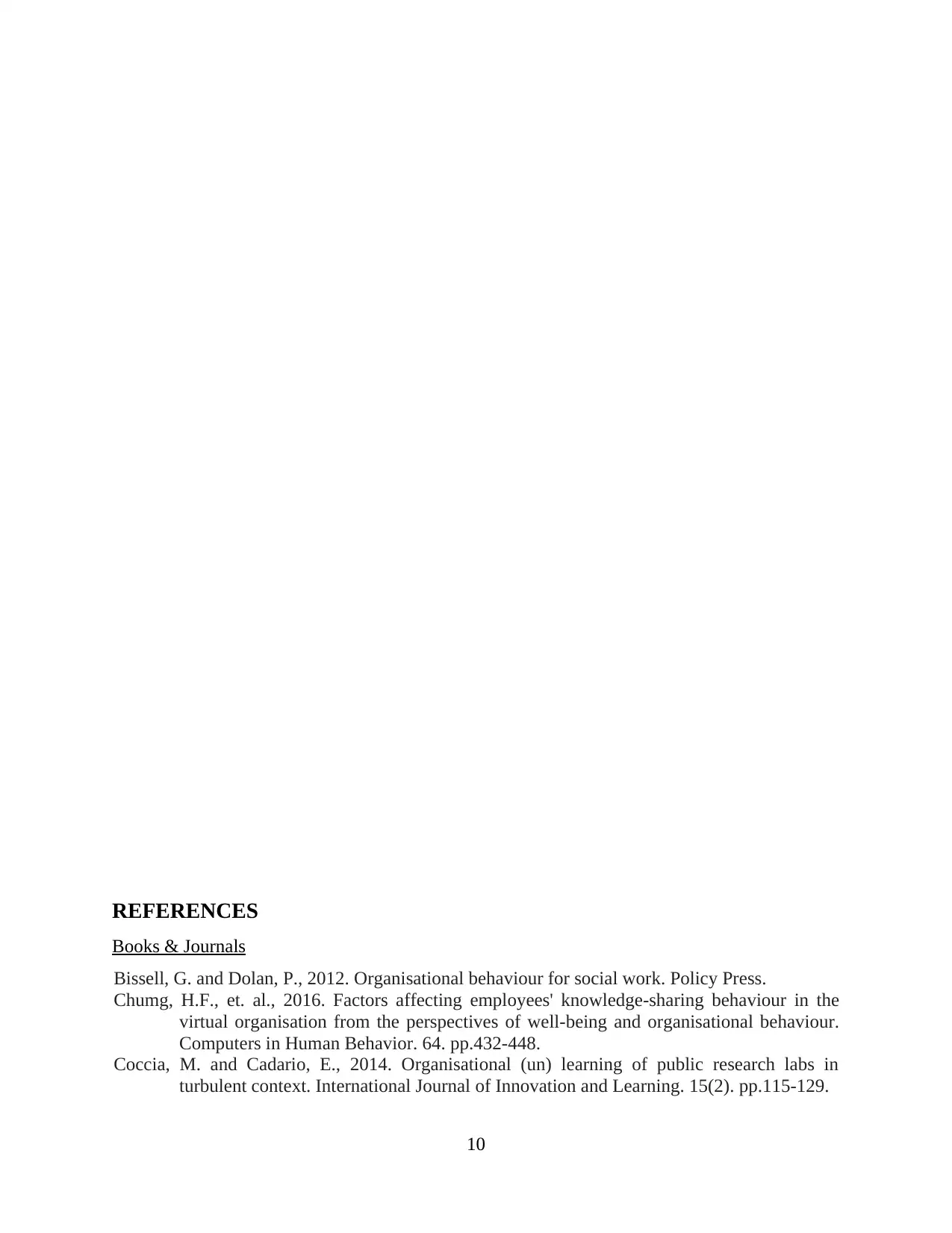
REFERENCES
Books & Journals
Bissell, G. and Dolan, P., 2012. Organisational behaviour for social work. Policy Press.
Chumg, H.F., et. al., 2016. Factors affecting employees' knowledge-sharing behaviour in the
virtual organisation from the perspectives of well-being and organisational behaviour.
Computers in Human Behavior. 64. pp.432-448.
Coccia, M. and Cadario, E., 2014. Organisational (un) learning of public research labs in
turbulent context. International Journal of Innovation and Learning. 15(2). pp.115-129.
10
Books & Journals
Bissell, G. and Dolan, P., 2012. Organisational behaviour for social work. Policy Press.
Chumg, H.F., et. al., 2016. Factors affecting employees' knowledge-sharing behaviour in the
virtual organisation from the perspectives of well-being and organisational behaviour.
Computers in Human Behavior. 64. pp.432-448.
Coccia, M. and Cadario, E., 2014. Organisational (un) learning of public research labs in
turbulent context. International Journal of Innovation and Learning. 15(2). pp.115-129.
10
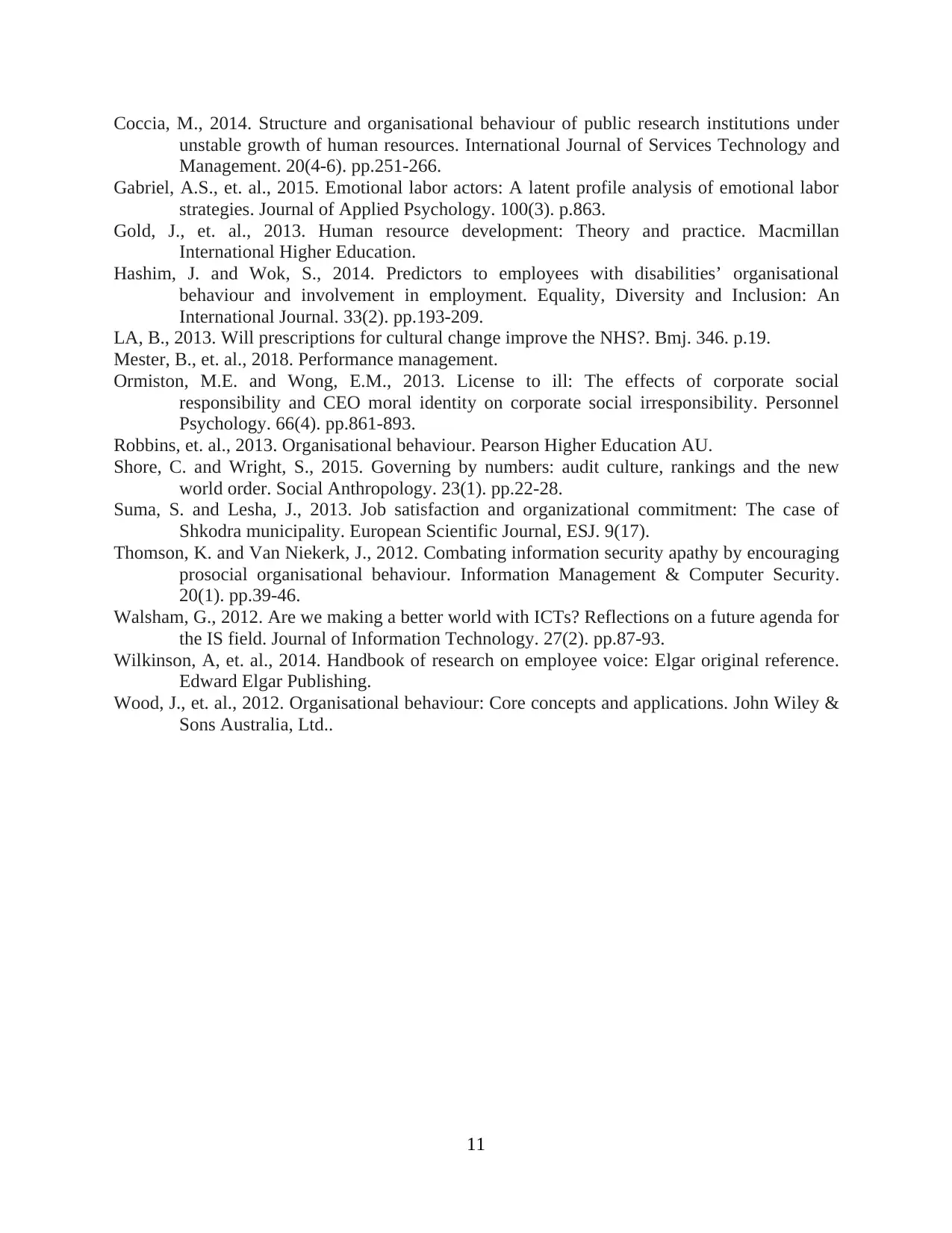
Coccia, M., 2014. Structure and organisational behaviour of public research institutions under
unstable growth of human resources. International Journal of Services Technology and
Management. 20(4-6). pp.251-266.
Gabriel, A.S., et. al., 2015. Emotional labor actors: A latent profile analysis of emotional labor
strategies. Journal of Applied Psychology. 100(3). p.863.
Gold, J., et. al., 2013. Human resource development: Theory and practice. Macmillan
International Higher Education.
Hashim, J. and Wok, S., 2014. Predictors to employees with disabilities’ organisational
behaviour and involvement in employment. Equality, Diversity and Inclusion: An
International Journal. 33(2). pp.193-209.
LA, B., 2013. Will prescriptions for cultural change improve the NHS?. Bmj. 346. p.19.
Mester, B., et. al., 2018. Performance management.
Ormiston, M.E. and Wong, E.M., 2013. License to ill: The effects of corporate social
responsibility and CEO moral identity on corporate social irresponsibility. Personnel
Psychology. 66(4). pp.861-893.
Robbins, et. al., 2013. Organisational behaviour. Pearson Higher Education AU.
Shore, C. and Wright, S., 2015. Governing by numbers: audit culture, rankings and the new
world order. Social Anthropology. 23(1). pp.22-28.
Suma, S. and Lesha, J., 2013. Job satisfaction and organizational commitment: The case of
Shkodra municipality. European Scientific Journal, ESJ. 9(17).
Thomson, K. and Van Niekerk, J., 2012. Combating information security apathy by encouraging
prosocial organisational behaviour. Information Management & Computer Security.
20(1). pp.39-46.
Walsham, G., 2012. Are we making a better world with ICTs? Reflections on a future agenda for
the IS field. Journal of Information Technology. 27(2). pp.87-93.
Wilkinson, A, et. al., 2014. Handbook of research on employee voice: Elgar original reference.
Edward Elgar Publishing.
Wood, J., et. al., 2012. Organisational behaviour: Core concepts and applications. John Wiley &
Sons Australia, Ltd..
11
unstable growth of human resources. International Journal of Services Technology and
Management. 20(4-6). pp.251-266.
Gabriel, A.S., et. al., 2015. Emotional labor actors: A latent profile analysis of emotional labor
strategies. Journal of Applied Psychology. 100(3). p.863.
Gold, J., et. al., 2013. Human resource development: Theory and practice. Macmillan
International Higher Education.
Hashim, J. and Wok, S., 2014. Predictors to employees with disabilities’ organisational
behaviour and involvement in employment. Equality, Diversity and Inclusion: An
International Journal. 33(2). pp.193-209.
LA, B., 2013. Will prescriptions for cultural change improve the NHS?. Bmj. 346. p.19.
Mester, B., et. al., 2018. Performance management.
Ormiston, M.E. and Wong, E.M., 2013. License to ill: The effects of corporate social
responsibility and CEO moral identity on corporate social irresponsibility. Personnel
Psychology. 66(4). pp.861-893.
Robbins, et. al., 2013. Organisational behaviour. Pearson Higher Education AU.
Shore, C. and Wright, S., 2015. Governing by numbers: audit culture, rankings and the new
world order. Social Anthropology. 23(1). pp.22-28.
Suma, S. and Lesha, J., 2013. Job satisfaction and organizational commitment: The case of
Shkodra municipality. European Scientific Journal, ESJ. 9(17).
Thomson, K. and Van Niekerk, J., 2012. Combating information security apathy by encouraging
prosocial organisational behaviour. Information Management & Computer Security.
20(1). pp.39-46.
Walsham, G., 2012. Are we making a better world with ICTs? Reflections on a future agenda for
the IS field. Journal of Information Technology. 27(2). pp.87-93.
Wilkinson, A, et. al., 2014. Handbook of research on employee voice: Elgar original reference.
Edward Elgar Publishing.
Wood, J., et. al., 2012. Organisational behaviour: Core concepts and applications. John Wiley &
Sons Australia, Ltd..
11
1 out of 13
Related Documents
Your All-in-One AI-Powered Toolkit for Academic Success.
+13062052269
info@desklib.com
Available 24*7 on WhatsApp / Email
![[object Object]](/_next/static/media/star-bottom.7253800d.svg)
Unlock your academic potential
© 2024 | Zucol Services PVT LTD | All rights reserved.





